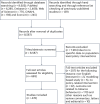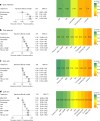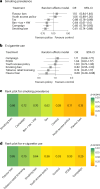A systematic review and network meta-analysis of population-level interventions to tackle smoking behaviour
- PMID: 39375543
- PMCID: PMC11659173
- DOI: 10.1038/s41562-024-02002-7
A systematic review and network meta-analysis of population-level interventions to tackle smoking behaviour
Abstract
This preregistered systematic review and meta-analysis (PROSPERO: CRD 42022311392) aimed to synthesize the effectiveness of all available population-level tobacco policies on smoking behaviour. Our search across 5 databases and leading organizational websites resulted in 9,925 records, with 476 studies meeting our inclusion criteria. In our narrative summary and both pairwise and network meta-analyses, we identified anti-smoking campaigns, health warnings and tax increases as the most effective tobacco policies for promoting smoking cessation. Flavour bans and free/discounted nicotine replacement therapy also showed statistically significant positive effects on quit rates. The network meta-analysis results further indicated that smoking bans, anti-tobacco campaigns and tax increases effectively reduced smoking prevalence. In addition, flavour bans significantly reduced e-cigarette consumption. Both the narrative summary and the meta-analyses revealed that smoking bans, tax increases and anti-tobacco campaigns were associated with reductions in tobacco consumption and sales. On the basis of the available evidence, anti-tobacco campaigns, smoking bans, health warnings and tax increases are probably the most effective policies for curbing smoking behaviour.
© 2024. The Author(s).
Conflict of interest statement
Competing interests: The authors declare no competing interests.
Figures




Similar articles
-
Smoking cessation medicines and e-cigarettes: a systematic review, network meta-analysis and cost-effectiveness analysis.Health Technol Assess. 2021 Oct;25(59):1-224. doi: 10.3310/hta25590. Health Technol Assess. 2021. PMID: 34668482
-
Mass media interventions for smoking cessation in adults.Cochrane Database Syst Rev. 2017 Nov 21;11(11):CD004704. doi: 10.1002/14651858.CD004704.pub4. Cochrane Database Syst Rev. 2017. PMID: 29159862 Free PMC article.
-
Mass media interventions for smoking cessation in adults.Cochrane Database Syst Rev. 2008 Jan 23;(1):CD004704. doi: 10.1002/14651858.CD004704.pub2. Cochrane Database Syst Rev. 2008. Update in: Cochrane Database Syst Rev. 2013 Jun 06;(6):CD004704. doi: 10.1002/14651858.CD004704.pub3. PMID: 18254058 Updated.
-
Pharmacological and electronic cigarette interventions for smoking cessation in adults: component network meta-analyses.Cochrane Database Syst Rev. 2023 Sep 12;9(9):CD015226. doi: 10.1002/14651858.CD015226.pub2. Cochrane Database Syst Rev. 2023. PMID: 37696529 Free PMC article.
-
Workplace interventions for smoking cessation.Cochrane Database Syst Rev. 2003;(2):CD003440. doi: 10.1002/14651858.CD003440. Cochrane Database Syst Rev. 2003. Update in: Cochrane Database Syst Rev. 2005 Apr 18;(2):CD003440. doi: 10.1002/14651858.CD003440.pub2. PMID: 12804467 Updated.
Cited by
-
Identifying Key Predictors of Smoking Cessation Success: Text-Based Feature Selection Using a Large Language Model.medRxiv [Preprint]. 2025 Jun 20:2025.06.18.25329854. doi: 10.1101/2025.06.18.25329854. medRxiv. 2025. PMID: 40585098 Free PMC article. Preprint.
-
Does the Path From Cigarette Smoking to Suicide Death Go Through the Hospital? A Causal Mediation Analysis in a National Canadian Sample.Tob Use Insights. 2025 Jun 9;18:1179173X251349612. doi: 10.1177/1179173X251349612. eCollection 2025. Tob Use Insights. 2025. PMID: 40497231 Free PMC article.
-
The impact of ageing, socio-economic differences and the evolution of morbidity on future health expenditure - a dynamic microsimulation.BMC Health Serv Res. 2025 Jul 12;25(1):952. doi: 10.1186/s12913-025-13072-2. BMC Health Serv Res. 2025. PMID: 40652199 Free PMC article.
-
Country-level prevalence of and factors associated with smoking cessation among adolescents across 91 countries.World J Pediatr. 2025 Aug 7. doi: 10.1007/s12519-025-00956-w. Online ahead of print. World J Pediatr. 2025. PMID: 40770458
References
-
- WHO Report on the Global Tobacco Epidemic 2021: Addressing New and Emerging Products (World Health Organization, 2021).
-
- Tackling NCDs: ‘Best Buys’ and Other Recommended Interventions for the Prevention and Control of Noncommunicable Diseases (World Health Organization, 2017).
Publication types
MeSH terms
Grants and funding
LinkOut - more resources
Full Text Sources
Medical

